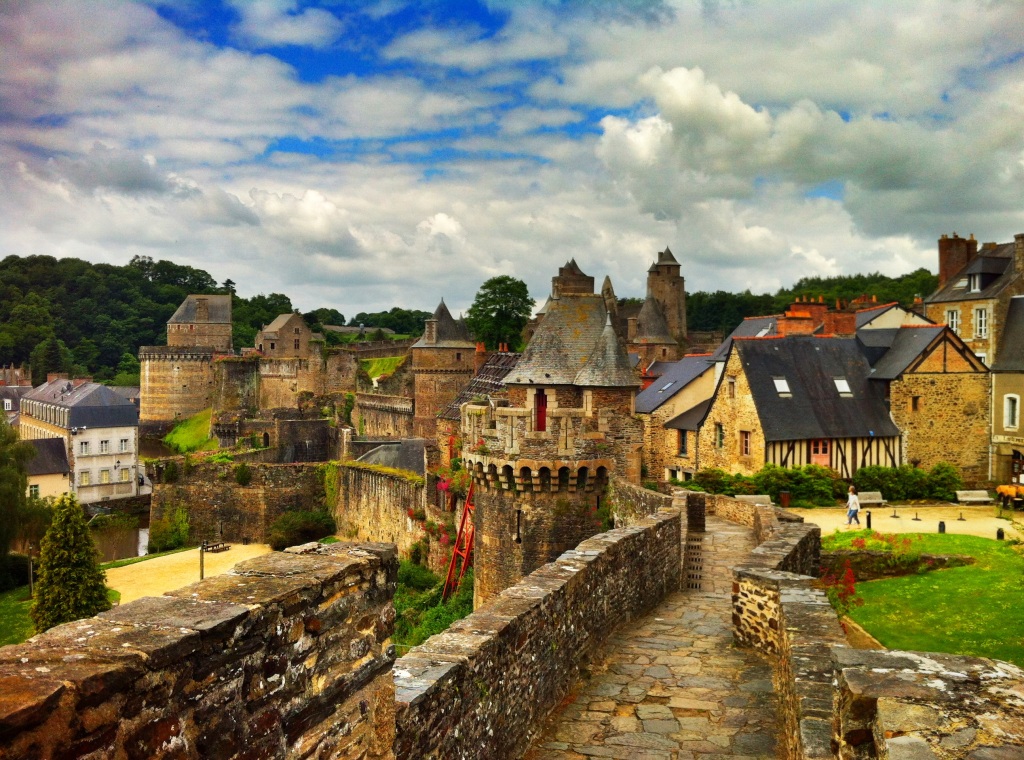
Our travels today took us from Dol de Bretagne southeast to Fougeres and Vitré. Both are towns with chateaus and medieval castles, and some of the best examples of them in France. They are two of our favorites. It’s so difficult to have favorites in France, as there are so many wonderful French villages, but these two rank up at the top.
Fourgeres is divided into two, with a lower part encompassing a medieval castle and town, and the upper, more modern town of Fougeres. A good way to start is in the upper part of town and then work your way downwards to the castle. You can walk through the public gardens of Place aux Arbres, which features terrific views of the castle medieval town below, and features hundred different versions of ferns (Figueres translates to fern). As you go walk through the gardens by way of a footpath you’ll make your way to the lower part of town (actually more scenic as most of the upper town had burned down in a fire in the 18th century) and the castle. As always, grab a map at the tourism office.
Usually the castle is set above the town, but not in the case of Fougeres. It was built below the town as there was water with a rock island in the middle; perfect place for a castle and natural moat. There’s a great tour that can be taken at little cost, but only in French. If you don’t speak French, there are digital readers available. You’ll want them as there’s a lot of history that goes with this chateau. This medieval castle has 13 towers and is said to be the largest in Europe.
The medieval quarter has lots of beautiful half-timbered buildings. The Place du Marchix is where the cattle market used to be held in medieval times. The houses here date to the 16th and 17th century.
Both Vitré and Fougeres were part of a defensive line that protected Bretagne from the rest of France, stretching from St. Malo to Nantes.
Vitré is another wonderful town with a quite well preserved, but much smaller castle than Fougeres. Still worth seeing, but probably even more enjoyable is the medieval town, perhaps one of the finest in Brittany, with its narrow streets that surround the castle that are great for strolling. Vitré still has many of the wooden structured homes some cantilevered out into the street, (an expression of wealth back then), allowing for covered strolling of the shops below.
The town is a listed Artistic and Heritage town and has many 15th and 16th century buildings remaining along with much of original ramparts of the town is also still intact. The 13th century castle, with many towers inset in the high walls and reached across a drawbridge is a quick tour and worth seeing.
Restaurant:
We ate lunch at Chez Pierre in Vitré, but both places seem to offer good choices.. It was full of business people having lunch there, which we took to be a good sign, and it was. We shared a Chèvre Chaud salad and a pizza with a 1/2 litre picket of rosé and it was all wonderful. A great place centrally located.
Interesting Historical Note:
When Brittany is mentioned, many people think of Anne de Bretagne, who was the Duchess of Bretagne for many years when her father died without a male to inherit to the Duchy. She also was the Queen of France, twice over, and became so in a rather interesting manner. When she became the Duchess at 13 years of age, she was concerned about protecting Bretagne against France, so she married by proxy, Maximillian of Austria, of the famous Hapsburg family. This didn’t go over well with Charles VIII, the King of France, her marrying one of France’s enemies, so he attacked and captured Anne and Bretagne. To settle things Anne then married Charles. Problem was Anne was married to Maximillian, and Charles was married as well to Margaret of Austria, who happened to be Maximillian’s sister. Well, nothing the Pope couldn’t take care of; the marriages were annulled and she became the Queen of France. When Charles died she married the new heir to the throne, Louis XII. Except he was already married to Charles’ sister, Joan. Again, with the help of the Pope, that married was annulled and she became Queen of France once again. Here’s more information about Anne of Bretagne.







